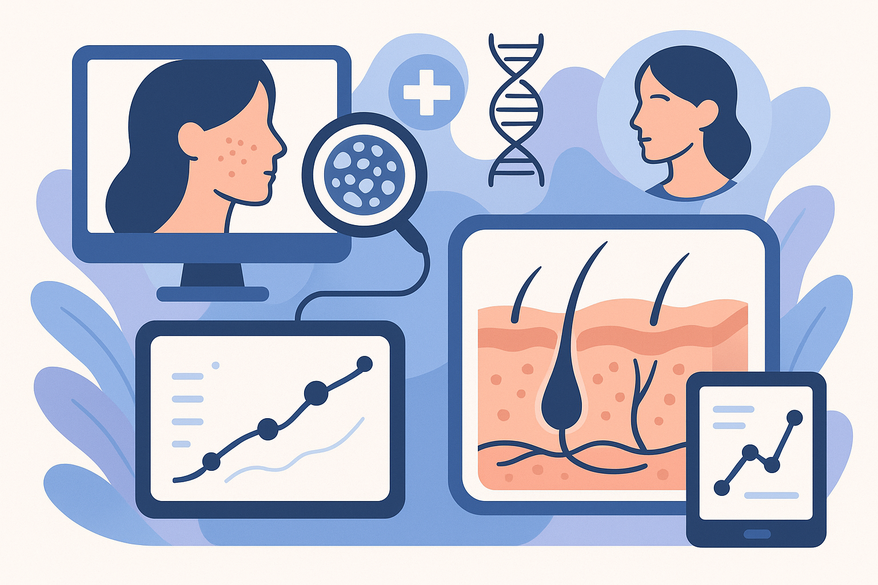Advanced Skin Analysis Technology: A Dermatology Revolution
Discover how advanced skin analysis technology is revolutionizing dermatology with precise, non-invasive diagnostics and personalized treatment plans.

Estimated reading time: 8 minutes
Key Takeaways
- Non-invasive imaging modalities reveal surface and subsurface skin details without discomfort.
- AI algorithms detect subtle patterns, improving early rash and lesion identification.
- Sensors measure hydration, pigmentation, elasticity, and blood flow in real time.
- Teledermatology expands access via portable devices and AI-driven triage.
- Patients and providers benefit from faster, data-driven, personalized diagnostics.
Table of Contents
- Background and Context: Dermatology Challenges
- Imaging Techniques
- Artificial Intelligence
- Sensor Technology
- Workflow Process
- Emerging Trends: Teledermatology
- Patient Benefits
- Provider Benefits
- Outcome Improvements
- Light-Touch on Rash Detector
- Conclusion
Background and Context: Dermatology Challenges
Before the rise of advanced skin analysis technology, clinicians relied on:
- Visual inspection: fast but can miss subtle or early lesions.
- Dermoscopy: magnifies surface features but lacks deep-tissue insight.
- Biopsy: gold-standard accuracy but invasive, may scar, and slow.
Key dermatology challenges include rapid, accurate rash detection and differentiating conditions that look alike (e.g., eczema vs. psoriasis). Digital analysis and advanced imaging deliver objective, reproducible data, reducing diagnostic delays.
Sources: Unveiling Skin's Secrets: The Power of Medical Imaging, How AI Skin Analysis Is Revolutionizing Personalized Skincare
Imaging Techniques
- High-resolution digital photography: captures fine surface topography with micron-level detail.
- Multispectral imaging: combines visible and near-infrared light to map pigmentation, hemoglobin, and melanin distribution.
- Confocal microscopy: produces en face optical slices of the epidermis and papillary dermis at cellular resolution.
- Optical coherence tomography (OCT): generates cross-sectional, 3D images of subsurface structures like hair follicles and sweat glands.
Sources: Skin Analysis Equipment 2023, Unveiling Skin's Secrets: The Power of Medical Imaging
Artificial Intelligence
- Machine learning classifiers: trained on labeled skin image datasets to recognize lesion types and disease markers.
- Deep neural networks: identify complex patterns in rashes, moles, and texture irregularities.
- Continuous refinement: models learn from millions of clinical images, improving accuracy over time.
For a deeper dive into the algorithms powering these capabilities, see Machine Learning Skin Analysis.
Sensor Technology
- Hydration sensors (capacitance measurement): quantify moisture levels in the stratum corneum.
- Pigmentation analysis (spectrophotometry): measure melanin index and tone uniformity.
- Texture and elasticity (cutometer readings): gauge skin firmness and wrinkle depth.
- Vascular mapping (laser Doppler flowmetry): assess microcirculation and inflammation markers.
Source: How AI Skin Analysis Is Revolutionizing Personalized Skincare
Workflow Process
- Patient positions target skin area under the scanning device.
- Device performs an automated multi-modal scan, capturing images and sensor data.
- AI engine analyzes the combined dataset against a normative database.
- System generates a quantitative report with metrics on fine lines, pigmentation score, inflammation index, UV damage, and pore health rating.
Automation cuts subjectivity, speeds up rash detection, and drives actionable results. Learn about the step-by-step methodology in Technical Process of Rash Detection.
Emerging Trends: Teledermatology
Teledermatology enhancements leverage advanced skin analysis technology to expand access and efficiency:
- Remote high-resolution scans: patients or nurses use portable devices or smartphone attachments to capture clinical-grade images.
- AI triage: cloud-based algorithms prioritize urgent cases, flag suspicious lesions, and route critical alerts to specialists.
- Portable and wearable monitoring: patch sensors and handheld scanners for continuous at-home tracking of hydration, inflammation, and UV exposure.
- Predictive analytics: longitudinal skin data feed machine learning models to forecast flare-ups, treatment responses, and disease risks.
Research ventures aim to boost sensitivity for early rash markers and accurately distinguish eczema, psoriasis, and contact dermatitis.
Source: Skin Analysis Equipment 2023
For additional insights into AI-driven rash diagnosis workflows, see How AI Diagnoses Rashes.
Benefits and Impacts: Patient Benefits
- Non-invasive, pain-free assessments enhance comfort and compliance.
- Early detection: conditions often flagged before visible symptoms appear.
- Personalized plans: quantitative metrics guide tailored skincare regimens and medical treatments.
Sources: Benefits of Advanced Facial Skin Analysis, How AI Skin Analysis Is Revolutionizing Personalized Skincare
Provider Benefits
- Data-driven diagnostics boost clinician confidence.
- Streamlined workflows: automated reports generated in under 5 minutes.
- Fewer unnecessary biopsies, reducing patient risk and clinic costs.
Source: Unveiling Skin's Secrets: The Power of Medical Imaging
Outcome Improvements
Early intervention can cut complication rates by up to 30% in inflammatory and precancerous conditions. Quantitative tracking of treatment progress improves long-term remission in chronic diseases.
Light-Touch on Rash Detector
Clinicians and patients are increasingly turning to tools like Rash Detector for instant, AI-driven rash assessments that provide actionable insights in minutes.

Conclusion: Advanced Skin Analysis Technology and the Future of Dermatology
Advanced skin analysis technology is transforming dermatology and rash detection by delivering faster, more accurate, and personalized diagnostics. Patients benefit from non-invasive, early detection and customized care plans. Providers gain data-driven confidence, streamlined workflows, and cost savings. As teledermatology, wearable monitoring, and predictive analytics evolve, the next generation of skin diagnostics will be more accessible and preventive. Continued collaboration between clinicians, researchers, and regulators is vital to harness these innovations responsibly. The future promises ubiquitous wearable monitors, AI-powered teledermatology networks, and proactive skin health maintenance—ushering in a new era of patient-centered dermatological care.
Sources: Unveiling Skin's Secrets: The Power of Medical Imaging, How AI Skin Analysis Is Revolutionizing Personalized Skincare
FAQ
- What is advanced skin analysis technology?
- It combines non-invasive imaging, AI algorithms, and sensor analytics to assess skin health objectively and accurately.
- How does AI improve dermatology diagnostics?
- AI detects patterns beyond visual inspection, enabling early and precise identification of skin conditions such as rashes, moles, and precancerous lesions.
- Can patients use these technologies remotely?
- Yes, teledermatology platforms and portable devices allow at-home scans, continuous monitoring, and real-time consultations with specialists.





